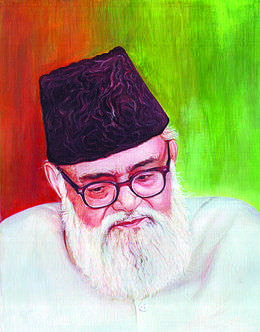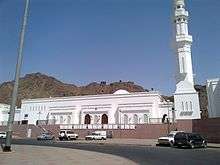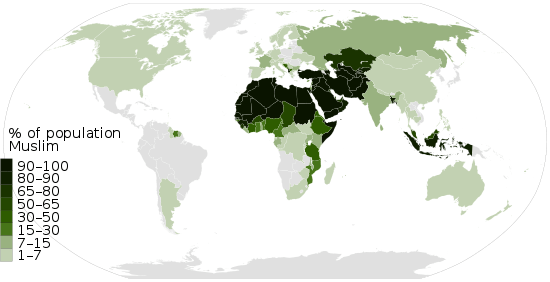Islamic schools and branches
There are three traditional types of schools in Islam: schools of jurisprudence, Sufi orders and schools of theology.
| Part of a series on |
| Islam |
|---|
 |
|
Overview
The original difference between Sunnis and Shias is over who the true first successor to Muhammad is. Shias believe Ali ibn Abi Talib is the true successor to Muhammad, while Sunnis consider Abu Bakr to hold that position. The Khawarij broke away from both the Shias and Sunnis during the First Fitna (the first Islamic Civil War) and subsequently opposed both the Shias and the Sunnis, often violently.
In addition, there are several differences within Sunni Islam and Shia Islam. Sunni Islam is separated into four main schools of jurisprudence, namely, Hanafi, Maliki, Shafi'i, Hanbali. These schools are named after Abu Hanifa, Malik bin Anas, al-Shafi'i, and Ahmad ibn Hanbal, respectively.[1]
Shia Islam, on the other hand, is separated into three major sects: Twelvers, Ismailis, and Zaydis. The vast majority of Shias are Twelvers (a 2012 estimate puts the figure as 94% of Shias being Twelvers)[2] to the extent that the term "Shia" frequently refers to Twelvers by default. The Twelver Shias are also notably the only sect of Muslims that complies with the saying of Muhammad that he would have twelve successors, a saying accepted by both Shia and Sunni Muslims. All mainstream Twelver Shia Muslims follow the same school of thought, the Jafari school of thought (named after Jafar as-Sadiq,[1] the sixth Shia Imam). All four founders of the Sunni schools of thought gained knowledge, either directly or indirectly, through Jafar as-Sadiq.
Zaydis, also known as Fivers, follow the Zayidi school of thought (named after Zayd ibn Ali[1]). Isma'ilism is another offshoot of Shia Islam that later split into Nizari Ismaili and Musta’li Ismaili, and then Mustaali was divided into Hafizi and Taiyabi Ismailis.[3] Tayyibi Ismailis, also known as "Bohras", are split between Da'udi Bohras, Sulaymani Bohras, and Alavi Bohras.[4]
Similarly, Kharijites were initially divided into five major branches: Sufris, Azariqa, Najdat, Adjarites and Ibadis. Of these, Ibadis are the only surviving branch of Kharijites.
In addition to the aforementioned groups, new schools of thought and movements like Quranist Muslims, and African American Muslims later emerged independently.[5]
Sectarian divisions
1. Sunni Islam
| |
|---|
 |
|
|
|
Lists |
|
|
Sunni Islam, also known as Ahl as-Sunnah wa'l-Jamā'h or simply Ahl as-Sunnah, is the largest denomination of Islam. The word Sunni comes from the word sunnah, which means the teachings and actions or examples of the Sahaba and the Islamic prophet, Muhammad.
The Sunnis believe that Muhammad did not specifically appoint a successor to lead the Muslim ummah (community) before his death, however they approve of the private election of the first companion, Abu Bakr.[6][7] Sunni Muslims regard the first four caliphs (Abu Bakr, Umar ibn al-Khattab, Uthman ibn Affan and Ali ibn Abi Talib) as "al-Khulafā'ur-Rāshidūn" or "The Rightly Guided Caliphs." Sunnis also believe that the position of caliph may be attained democratically, on gaining a majority of the votes, but after the Rashidun, the position turned into a hereditary dynastic rule because of the divisions started by the Umayyads and others. After the fall of the Ottoman Empire in 1923, there has never been another caliph as widely recognized in the Muslim world.
In recent times, followers of the classical Sunni schools of jurisprudence and kalam (rationalistic theology) on one hand and Islamists and Salafis such as Wahhabis and Ahle Hadith, who follow a literalist reading of early Islamic sources, on the other, have laid competing claims to represent orthodox Sunni Islam.[8] Anglophone Islamic currents of the former type are sometimes referred to as "traditional Islam".[9][10]
2. Shia Islam
| Part of a series on Islam Shia Islam |
|---|
 |
|
Beliefs and practices |
|
|
Holy women |
|
|
Shia Islam is the second-largest denomination of Islam, comprising 10–20%[11] of the total Muslim population.[12] Although a minority in the Muslim world, Shia Muslims constitute the majority of the Muslim populations in Iran, Iraq, Lebanon, Bahrain and Azerbaijan as well as significant minorities in Syria, Turkey, eastern Africa, south Asia, Yemen, and Saudi Arabia and other parts of the Persian Gulf.[13]
In addition to believing in the authority of the Quran and teachings of Muhammad, Shia believe that Muhammad's family, the Ahl al-Bayt (the "People of the House"), including his descendants known as Imams, have special spiritual and political authority over the community[14] and believe that Ali ibn Abi Talib, Muhammad's cousin and son-in-law, was the first of these Imams and was the rightful successor to Muhammad, and thus reject the legitimacy of the first three Rashidun caliphs.[15]
The Shia Islamic faith is broad and includes many different groups. There are various Shia theological beliefs, schools of jurisprudence, philosophical beliefs, and spiritual movements.
Major sub-denominations
- The Twelvers believe in twelve Imams and are the only school to comply with Hadith of the Twelve Successors, where Muhammad stated that he would have twelve successors.
- Ismailism, including the Nizārī, Sevener, Mustaali, Dawoodi Bohra, Hebtiahs Bohra, Sulaimani Bohra and Alavi Bohra sub-denominations.
- The Zaidiyyah historically come from the followers of Zayd ibn Ali.
- The Alawites are a distinct religion that developed in the 9th/10th century. Historically, Twelver Shia scholars (such as Shaykh Tusi) did not consider Alawites as Shia Muslims while condemning their heretical beliefs.[16] Ibn Taymiyyah also pointed out that Alawites were not Shi'ites.[17]
- The Druze are a distinct traditional religion that developed in the 11th century as an offshoot of Ismailism. Druze are not generally considered Muslims.[18][19]
Ghulat movements in history
Muslim groups who either ascribe divine characteristics to some figures of Islamic history (usually a member of Muhammad's family, Ahl al-Bayt) or hold beliefs deemed deviant by mainstream Shi'i theology were called Ghulat.
3. Kharijite Islam
Kharijite (literally, "those who seceded") is a general term embracing a variety of Muslim sects which, while originally supporting the Caliphate of Ali, later on fought against him and eventually succeeded in his martyrdom while he was praying in the mosque of Kufa. While there are few remaining Kharijite or Kharijite-related groups, the term is sometimes used to denote Muslims who refuse to compromise with those with whom they disagree.
The major Kharijite sub-sect today is the Ibadi. The sect developed out of the 7th century Islamic sect of the Kharijites. While Ibadi Muslims maintain most of the beliefs of the original Kharijites, they have rejected the more aggressive methods.
A number of Kharijite groups went extinct in the past:
- Sufris were a sect of Islam in the 7th and 8th centuries, and a part of the Kharijites. Their most important branches were the:
- Harūrīs were an early Muslim sect from the period of the Four Rightly-Guided Caliphs (632–661 CE), named for their first leader, Habīb ibn-Yazīd al-Harūrī.
- Azariqa
- Najdat
- Adjarites
Sufi orders
| Part of a series on Islam Sufism |
|---|
|
List of sufis |
|
|
Sufism is Islam's mystical-ascetic dimension and is represented by schools or orders known as Tasawwufī-Ṭarīqah. It is seen as that aspect of Islamic teaching that deals with the purification of inner self. By focusing on the more spiritual aspects of religion, Sufis strive to obtain direct experience of God by making use of "intuitive and emotional faculties" that one must be trained to use.[20]
The following list contains some notable Sufi orders:
- The Azeemiyya order was founded in 1960 by Qalandar Baba Auliya, also known as Syed Muhammad Azeem Barkhia.
- The Bektashi order was founded in the 13th century by the Islamic saint Haji Bektash Veli, and greatly influenced during its formulative period by the Hurufi Ali al-'Ala in the 15th century and reorganized by Balım Sultan in the 16th century. Because of its adherence to the Twelve Imams it is classified under Twelver Shia Islam.
- The Chishti order (Persian: چشتیہ) was founded by (Khawaja) Abu Ishaq Shami ("the Syrian"; died 941) who brought Sufism to the town of Chisht, some 95 miles east of Herat in present-day Afghanistan. Before returning to the Levant, Shami initiated, trained and deputized the son of the local Emir (Khwaja) Abu Ahmad Abdal (died 966). Under the leadership of Abu Ahmad's descendants, the Chishtiyya as they are also known, flourished as a regional mystical order. The founder of the Chishti Order in South Asia was Moinuddin Chishti.
- The Kubrawiya order was founded in the 13th century by Najmuddin Kubra in Bukhara in modern-day Uzbekistan.[21]
- The Mevlevi order is better known in the West as the "whirling dervishes".
- Mouride is most prominent in Senegal and The Gambia, with headquarters in the holy city of Touba, Senegal.[22]
- The Naqshbandi order was founded in 1380 by Baha-ud-Din Naqshband Bukhari. It is considered by some to be a "sober" order known for its silent dhikr (remembrance of God) rather than the vocalized forms of dhikr common in other orders. The Süleymani and Khalidiyya orders are offshoots of the Naqshbandi order.
- The Ni'matullahi order is the most widespread Sufi order of Persia today. It was founded by Shah Ni'matullah Wali (d. 1367), established and transformed from his inheritance of the Ma'rufiyyah circle.[23] There are several suborders in existence today, the most known and influential in the West following the lineage of Javad Nurbakhsh, who brought the order to the West following the 1979 Iranian Revolution.
- The Noorbakshia order,[24] also called Nurbakshia,[25][26] claims to trace its direct spiritual lineage and chain (silsilah) to the Islamic prophet Muhammad, through Ali, by way of Ali Al-Ridha. This order became known as Nurbakshi after Shah Syed Muhammad Nurbakhsh Qahistani, who was aligned to the Kubrawiya order.
- The Oveysi (or Uwaiysi) order claims to have been founded 1,400 years ago by Uwais al-Qarni from Yemen.
- The Qadiri order is one of the oldest Sufi Orders. It derives its name from Abdul-Qadir Gilani (1077–1166), a native of the Iranian province of Gīlān. The order is one of the most widespread of the Sufi orders in the Islamic world, and can be found in Central Asia, Turkey, Balkans and much of East and West Africa. The Qadiriyyah have not developed any distinctive doctrines or teachings outside of mainstream Islam. They believe in the fundamental principles of Islam, but interpreted through mystical experience. The Ba'Alawi order is an offshoot of Qadiriyyah.
- Senussi is a religious-political Sufi order established by Muhammad ibn Ali as-Senussi. As-Senussi founded this movement due to his criticism of the Egyptian ulema.[27]
- The Shadhili order was founded by Abu-l-Hassan ash-Shadhili. Followers (murids Arabic: seekers) of the Shadhiliyya are often known as Shadhilis.[28][29]
- The Suhrawardiyya order (Arabic: سهروردية) is a Sufi order founded by Abu al-Najib al-Suhrawardi (1097–1168).
- The Tijaniyyah order attach a large importance to culture and education, and emphasize the individual adhesion of the disciple (murid).
Schools of jurisprudence
| Part of a series on |
| Islamic jurisprudence (fiqh) |
|---|
 |
|
| Islamic studies |

Islamic schools of jurisprudence, known as madhhabs, differ in the methodology they use to derive their rulings from the Quran and hadith.
Sunni
In terms of religious jurisprudence (fiqh), Sunnism contains several schools of thought (madhhab) such as:
- the Hanafi school, founded by Abu Hanifa an-Nu'man.
- the Maliki school, founded by Malik ibn Anas.
- the Shafi'i school, founded by Muhammad ibn Idris ash-Shafi'i.
- the Hanbali school, founded by Ahmad ibn Hanbal.
The Ẓāhirī school or al-Ẓāhirīyyah, founded by Dawud al-Zahiri. Some consider it as a fifth madhhab, but some do not.
The Salafi movement, is a reform branch or revivalist movement in Sunni Islam that does not believe in strictly following one particular madhhab. They include the Wahhabi movement, an Islamic doctrine and religious movement founded by Muhammad ibn Abd al-Wahhab and the Ahle Hadith movement whose followers call themselves Ahl al-Hadith while others consider them to be a branch of the Salafi or Wahhabi movement.
Shia
The major Shia school of jurisprudence is the Ja'fari or Imāmī school.[31] It is further divided into two branches, the Usuli school, which favors the exercise of ijtihad,[32] and the Akhbari school, which holds the traditions (aḵbār) of the Imams to be the main source of religious knowledge.[33] Minor schools include the Ismāʿīlī school (Mustaʿlī-Fāṭimid Ṭayyibi Ismāʿīlīyah), and the Zaydī school, which have closer affinity to Sunni jurisprudence.[31][34][35]
Ibadi
The fiqh or jurisprudence of Ibadis is relatively simple. Absolute authority is given to the Qur'an and hadith; new innovations accepted on the basis of qiyas (analogical reasoning) were rejected as bid'ah (heresy) by the Ibadis. That differs from the majority of Sunnis[36] but agrees with most Shi'ites[37] and the Zahiri and early Hanbali schools of Sunnism.[38][39][40]
Schools of Islamic theology
Aqidah is an Islamic term meaning "creed", doctrine, or article of faith.[41][42] There have existed many schools of Islamic theology, not all of which survive to the present day. Major themes of theological controversies in Islam have included predestination and free will, the nature of the Quran, the nature of the divine attributes, apparent and esoteric meaning of scripture, and the role of dialectical reasoning in the Islamic doctrine.
| Part of a series on Islam Aqidah |
|---|
 |
|
Six articles of belief
|
|
Including: 1Al-Ahbash; Barelvis 2Deobandi 3Salafis (Ahl-i Hadith & Wahhabis) 4Sevener-Qarmatians, Assassins & Druzes 5Alawites, Qizilbash & Bektashism; 6Jahmīyya 7Ajardi, Azariqa, Bayhasiyya, Najdat & Sūfrī 8Nukkari; 9Bektashis & Qalandaris; Mevlevis, Süleymancıs & various Ṭarīqah 10Bahshamiyya, Bishriyya & Ikhshîdiyya |
Sunni
Classical
Kalām is the Islamic philosophy of seeking theological principles through dialectic. In Arabic, the word literally means "speech/words". A scholar of kalām is referred to as a mutakallim (Muslim theologian; plural mutakallimūn). There are many schools of Kalam, the main ones being the Ash'ari and Maturidi schools in Sunni Islam.
Ash'ari
Ash'arism is a school of theology founded in the 10th century by Abu al-Hasan al-Ash'ari. The Asharite view was that comprehension of the unique nature and characteristics of God were beyond human capability.
Maturidi
Maturidism is a school of theology founded by Abu Mansur Al Maturidi, which is a close variant of the Ash'ari school. Points which differ are the nature of belief and the place of human reason. The Maturidis state that belief (iman) does not increase nor decrease but remains static; it is piety (taqwa) which increases and decreases. The Ash'aris say that belief does in fact increase and decrease. The Maturidis say that the unaided human mind is able to find out that some of the more major sins such as alcohol or murder are evil without the help of revelation. The Ash'aris say that the unaided human mind is unable to know if something is good or evil, lawful or unlawful, without divine revelation.
Traditionalist theology
Traditionalist theology, sometimes referred to as the Athari school, derives its name from the word "tradition" as a translation of the Arabic word hadith or from the Arabic word athar, meaning "narrations". The traditionalist creed is to avoid delving into extensive theological speculation. They rely on the Qur'an, the Sunnah, and sayings of the Sahaba, seeing this as the middle path where the attributes of Allah are accepted without questioning their nature (bi la kayf). Ahmad bin Hanbal is regarded as the leader of the traditionalist school of creed. The term athari has been historically synonymous with Salafi. The central aspect of traditionalist theology is its definition of Tawhid, meaning literally unification or asserting the oneness of Allah.[43][44][45][46]
Murji'ah
Murji'ah was a name for an early politico-religious movement which came to refer to all those who identified faith (iman) with belief to the exclusion of acts.[47]
Qadariyyah
Qadariyyah is an originally derogatory term designating early Islamic theologians who asserted that humans possess free will, whose exercise makes them responsible for their actions, justifying divine punishment and absolving God of responsibility for evil in the world.[48][49] Some of their doctrines were later adopted by the Mu'tazilis and rejected by the Ash'aris.[48]
Mu'tazili
Mu'tazili theology originated in the 8th century in al-Basrah when Wasil ibn Ata left the teaching lessons of Hasan al-Basri after a theological dispute. He and his followers expanded on the logic and rationalism of Greek philosophy, seeking to combine them with Islamic doctrines and show that the two were inherently compatible. The Mu'tazili debated philosophical questions such as whether the Qur'an was created or eternal, whether evil was created by God, the issue of predestination versus free will, whether God's attributes in the Qur'an were to be interpreted allegorically or literally, and whether sinning believers would have eternal punishment in hell.
Jahmiyyah
Jahmis were the alleged followers of the early Islamic theologian Jahm bin Safwan who associate himself with Al-Harith ibn Surayj. He was an exponent of extreme determinism according to which a man acts only metaphorically in the same way in which the sun acts or does something when it sets.[50]
Bāṭeniyyah
The Batiniyyah is a name given to an allegoristic type of scriptural interpretation developed among some Shia groups, stressing the bāṭin (inward, esoteric) meaning of texts. It has been retained by all branches of Isma'ilism and its Druze offshoot. Alevism, Bektashism and folk religion, Hurufis and Alawites practice a similar system of interpretation.[51]
Later movements
African-American movements
Many slaves brought from Africa to the Western hemisphere were Muslim. Although it is thought that the Islam of slaves did not survive past 1920,[52] the early twentieth century saw the rise of distinct Islamic movements within the African-American community, such as the Moorish Science Temple of America and the Nation of Islam. They sought to ascribe Islamic heritage to African-Americans, thereby giving much emphasis on racial aspects[53] (see Black nationalism). These Black Muslim movements often differed greatly in doctrine from mainstream. They included:
- Moorish Science Temple of America, founded in 1913 by Noble Drew Ali (born Timothy Drew). He claimed it was a sect of Islam but he also drew inspiration from Buddhism, Christianity, Gnosticism and Taoism. Its significant divergences from mainstream Islam and strong African-American ethnic character[54] make its classification as an Islamic denomination a matter of debate among Muslims and scholars of religion.
- Nation of Islam, founded by Wallace Fard Muhammad in Detroit in 1930,[55] with a declared aim of "resurrecting" the spiritual, mental, social and economic condition of the black man and woman of America and the world. The group believes Fard Muhammad was God on earth,[55][56] a belief viewed as shirk by mainstream Muslims. It does not see Muhammad as the final prophet, but Elijah Muhammad as the "Messenger of Truth" and only allows people of black ethnicity and believes they are the original race on earth.
- American Society of Muslims: Warith Deen Mohammed established the American Society of Muslims in 1975. This offshoot wanted to bring its teachings more in line with mainstream Sunni Islam, establishing mosques instead of temples and promoting the Five pillars of Islam.[57][58]
- Five-Percent Nation
- United Nation of Islam
Ahmadiyya Movement In Islam
| Part of a series on:
Ahmadiyya |
|---|
 |
|
|
Distinct views |
|
Key literature
|
|
Key sites |
The Ahmadiyya Movement in Islam was founded in India in 1889 by Mirza Ghulam Ahmad of Qadian, who claimed to be the Promised Messiah ("Second Coming of Christ"), the Mahdi awaited by the Muslims as well as a "subordinate" prophet to the Prophet Muhammad.[59] Ahmadis believed that it was Mirza Ghulam Ahmad's job restore the original Sharia given to Muhammad by guiding Ummah back to the "true" Islam and defeat the attacks on Islam by other religions. Ahmadis claim to practice the pristine form of Islam as followed by Muhammad and his Earliest Followers.[60][61][62]
There are a wide variety of distinct teaching of Ahmadis compared to most other Muslims which include the interpretation of the term of Khatam an Nabiyyin[63], Interpretation of the Messiah's Second Coming [64], complete Rejection of Abrogation/cancellation of Quranic verses[65], belief that Jesus has died[66], conditions of the Jihad of the Sword are no longer met[67], belief that revelation (as long as no new Shariat) will never end[68], belief in cyclical nature of history until Muhammad[68], and belief in the implausibility of a contradiction between Islam and science.[69] These deviations from normative Islamic thought have resluted in severe persecution of Ahmadis in some Muslim countries particularly Pakistan where they have been branded as Non-Muslims and their Islamic religious practices are punishable by the Ahmadi-Specific laws in the penal code.[70]
The followers are divided into two groups the first being the Ahmadiyya Muslim Community, currently the dominant group, and the Lahore Ahmadiyya Movement for the Propagation of Islam. The larger group takes a literalist view believing that Mirza Ghulam Ahmad was a Ummati Nabi subservient to Muhammad while the latter believing that he was only a Religious Reformer and a Prophet only in an allegorical sense. Both groups are active in Tabligh or Islamic missionary work and have produced vasts amounts of Islamic literature, translations of the Quran, Hadith translations and tafsir, Comparative religion works, Quranic Tafsirs, and a multitiude of Seerahs of Muhammad among others. As such their influence far exceeds their numbers.[71] Muslims from more Orthodox sects of Islam have adopted many Ahmadi polemics and understandings of other religions,[72] along with the Ahmadiyya approach to reconciling Islamic and western education as well as establishing Islamic School systems particularly in Africa.[73]
Gülen / Hizmet movement
The Gülen movement, usually referred to as the Hizmet movement,[74] established in the 1970s as an offshoot of the Nur Movement[75] and led by the Turkish Islamic scholar and preacher Fethullah Gülen in Turkey, Central Asia, and in other parts of the world, is active in education, with private schools and universities in over 180 countries as well as with many American charter schools operated by followers. It has initiated forums for interfaith dialogue.[76][77] The Cemaat movement's structure has been described as a flexible organizational network.[78] Movement schools and businesses organize locally and link themselves into informal networks.[79] Estimates of the number of schools and educational institutions vary widely; it appears there are about 300 Gülen movement schools in Turkey and over 1,000 schools worldwide.[80][81]
Islamism
Islamism is a set of political ideologies, derived from various fundamentalist views, which hold that Islam is not only a religion but a political system that should govern the legal, economic and social imperatives of the state. Many Islamists do not refer to themselves as such and it is not a single particular movement. Religious views and ideologies of its adherents vary, and they may be Sunni Islamists or Shia Islamists depending upon their beliefs. Islamist groups include groups such as Al-Qaeda, the organizer of the September 11, 2001 attacks and perhaps the most prominent; and the Muslim Brotherhood, the largest and perhaps the oldest. Although violence is often employed by some organizations, most Islamist movements are nonviolent.
Muslim Brotherhood
The Al-Ikhwan Al-Muslimun (with Ikhwan الإخوان brethren) or Muslim Brotherhood, is an organisation that was founded by Egyptian scholar Hassan al-Banna, a graduate of Dar al-Ulum. With its various branches, it is the largest Sunni movement in the Arab world, and an affiliate is often the largest opposition party in many Arab nations. The Muslim Brotherhood is not concerned with theological differences, accepting Muslims of any of the four Sunni schools of thought. It is the world's oldest and largest Islamist group. Its aims are to re-establish the Caliphate and in the meantime, push for more Islamisation of society. The Brotherhood's stated goal is to instill the Qur'an and sunnah as the "sole reference point for... ordering the life of the Muslim family, individual, community... and state".
Jamaat-e-Islami

The Jamaat-e-Islami (or JI) is an Islamist political party in the Indian subcontinent. It was founded in Lahore, British India, by Sayyid Abul Ala Maududi (with alternative spellings of last name Maudoodi) in 1941 and is the oldest religious party in Pakistan. Today, sister organizations with similar objectives and ideological approaches exist in India (Jamaat-e-Islami Hind), Bangladesh (Jamaat-e-Islami Bangladesh), Kashmir (Jamaat-e-Islami Kashmir), and Sri Lanka, and there are "close brotherly relations" with the Islamist movements and missions "working in different continents and countries", particularly those affiliated with the Muslim Brotherhood (Akhwan-al-Muslimeen). The JI envisions an Islamic government in Pakistan and Bangladesh governing by Islamic law. It opposes Westernization—including secularization, capitalism, socialism, or such practices as interest based banking, and favours an Islamic economic order and Caliphate.
Hizb ut-Tahrir
Hizb ut-Tahrir (Arabic: حزب التحرير) (Translation: Party of Liberation) is an international, pan-Islamist political organization which describes its ideology as Islam, and its aim the re-establishment of the Islamic Khilafah (Caliphate) to resume Islamic ways of life in the Muslim world. The caliphate would unite the Muslim community (Ummah)[82] upon their Islamic creed and implement the Shariah, so as to then carry the proselytizing of Islam to the rest of the world.[83]
Liberal Muslims
Liberal and progressive movements have in common a religious outlook which depends mainly on Ijtihad or re-interpretations of scriptures. Liberal Muslims at thought have led to the birth of certain small denominations from primarily unaffiliated followers who believe in greater autonomy of the individual in interpretation of scripture, a critical examination of religious texts, gender equality, human rights, LGBT rights and a modern view of culture, tradition, and other ritualistic practices in Islam.
Mahdavia
Mahdavia, or Mahdavism, is a Mahdiist sect founded in late 15th century India by Syed Muhammad Jaunpuri, who declared himself to be the Hidden Twelfth Imam of the Twelver Shia tradition.[84] They follow many aspects of the Sunni doctrine. Zikri Mahdavis, or Zikris, are an offshoot of the Mahdavi movement.[85]
Non-denominational Islam
Non-denominational Muslims is an umbrella term that has been used for and by Muslims who do not belong to or do not self-identify with a specific Islamic denomination.[86][87][88][89] A quarter of the world's Muslims are non-denominational Muslims.[90]
Tolu-e-Islam
Tolu-e-Islam ("Resurgence of Islam") is a non-denominational Muslim organization based in Pakistan, with members throughout the world.[91] The movement was initiated by Ghulam Ahmed Pervez.
Quranism
Quranism (Arabic: قرآنيون, romanized: Qur'āniyūn) is an Islamic branch that holds the Quran to be the only canonical text in Islam, as opposed to hadith and often sunnah collections. This is in contrast to orthodox Muslims, who consider hadiths essential to the Islamic faith.[92] Quranistic movements include Abdullah Chakralawi's Ahle Qur'an[93][94] and Rashad Khalifa's United Submitters International.[95]
Salafism and Wahhabism
Ahl-i Hadith
Ahl-i Hadith is a movement which emerged in the Indian subcontinent in the mid-19th century. Followers call themselves Ahl-i Hadith or Salafi, while others consider them to be a branch of the Salafi or Wahhabi movement.[96][97][98]
Salafi movement
| Part of a series on:
Salafi movement |
|---|
 Sab'u Masajid, Saudi Arabia |
|
Ideology and influences |
|
Founders and key figures |
|
Notable universities |
|
|
|
The Salafi movement is an ultra-conservative[99] reform[100] movement within Sunni Islam that emerged in the second half of the 19th century and advocated a return to the traditions of the "devout ancestors" (the salaf). The doctrine can be summed up as taking "a fundamentalist approach to Islam, emulating the Prophet Muhammad and his earliest followers—al-salaf al-salih, the 'pious forefathers'....They reject religious innovation, or bid'ah, and support the implementation of sharia (Islamic law)."[101] The movement is often divided into three categories: the largest group are the purists (or quietists), who avoid politics; the second largest group are the activists, who get involved in politics; the smallest group are the jihadists, who form a small (yet infamous) minority.[101] Most of the violent Islamist groups come from the Salafi movement and their subgroups. In recent years, the Salafi doctrine has often been correlated with the jihad of terrorist organizations such as Al Qaeda and those groups in favor of killing innocent civilians.[102]<[103] The Salafi movement is often described as being synonymous with Wahhabism, but Salafists consider the term "Wahhabi" derogatory.[104]
Islamic Modernism
Islamic Modernism, also sometimes referred to as Modernist Salafism,[105][106][107][108][109] is a movement that has been described as "the first Muslim ideological response"[110] attempting to reconcile Islamic faith with modern Western values such as nationalism, democracy, civil rights, rationality, equality, and progress.[111]
Wahhabism
The Wahhabi movement was created by Muhammad ibn Abd-al-Wahhab in the Arabian peninsula, and was instrumental in the rise of the House of Saud to power. It is a strict orthodox form and a branch of sunni Islam, with fundamentalist views, believing in a strict literal interpretation of the Quran. The terms Wahhabism and Salafism are often used interchangeably, although the word Wahhabi is specific for followers of Muhammad ibn Abd-al-Wahhab. Wahhabism has been accused of being "a source of global terrorism"[112][113] and causing disunity in Muslim communities, and criticized for its followers' destruction of historic sites.[114][115][116]
Population of the branches
| Denomination | Population |
|---|---|
| Sunni | Varies: 75% - 90%[117][118] |
| Non-denominational Muslim | 25%[90] |
| Shia | Varies: 10% -13%[119] |
| Ahmadiyya | 10–20 million[120] |
| Ibadi | 2.7 million[121] |
| Quranism | n/a |
See also
References
- "Schools of Islamic law and their differences". Untold Islam. Maslaha. Retrieved 28 November 2018.
- Guidère, Mathieu (2012). Historical Dictionary of Islamic Fundamentalism. Scarecrow Press. p. 319. ISBN 978-0-8108-7965-2.
- Öz, Mustafa, Mezhepler Tarihi ve Terimleri Sözlüğü (The History of madh'habs and its terminology dictionary), Ensar Publications, İstanbul, 2011.
- "Branches of Shia Islam: Ismailis, Twelvers, and Bohras". Ismailimail. Retrieved 28 November 2018.
- The Amman Message summary – Official website
- Razwy, Sayed Ali Asgher. A Restatement of the History of Islam & Muslims. pp. 331–335.
- History of the Islamic Caliphate (in Urdu). Lahore.
In pre-Islamic times, the custom of the Arabs was to elect their chiefs by a majority vote...the same principle was adopted in the election of Abu Bakr.
- Brown, Jonathan A.C. (2009). Hadith: Muhammad's Legacy in the Medieval and Modern World. Oneworld Publications (Kindle edition). p. 180.
- Kasper Mathiesen (2013). "Anglo-American 'Traditional Islam' and Its Discourse of Orthodoxy" (PDF). Journal of Arabic and Islamic Studies. 13: 191–219.
- "The Muslim 500" (PDF).
- See
- "Mapping the Global Muslim Population: A Report on the Size and Distribution of the World's Muslim Population". Pew Research Center. 2009-10-07. Retrieved 2013-09-24.
The Pew Forum's estimate of the Shia population (10–13%) is in keeping with previous estimates, which generally have been in the range of 10–15%. Some previous estimates, however, have placed the number of Shias at nearly 20% of the world's Muslim population.
- "Shia". Berkley Center for Religion, Peace, and World Affairs. Archived from the original on December 15, 2012. Retrieved December 5, 2011.
Shi'a Islam is the second largest branch of the tradition, with up to 200 million followers who comprise around 15% of all Muslims worldwide...
- "Religions". The World Factbook. Central Intelligence Agency. Retrieved 2010-08-25.
Shia Islam represents 10–20% of Muslims worldwide...
- "Mapping the Global Muslim Population: A Report on the Size and Distribution of the World's Muslim Population". Pew Research Center. 2009-10-07. Retrieved 2013-09-24.
- Miller, Tracy, ed. (October 2009). Mapping the Global Muslim Population: A Report on the Size and Distribution of the World's Muslim Population (PDF). Pew Research Center. Archived from the original (PDF) on 2009-10-10. Retrieved 2009-10-08.
- "Shi'ite – Islam".
- Corbin (1993), pp. 45–51
- Tabatabaei (1979), pp. 41–44
- Barfi, Barak. "The Real Reason Why Iran Backs Syria".
- "The Nusayris are more infidel than Jews or Christians, even more infidel than many polytheists. They have done greater harm to the community of Muhammad than have the warring infidels such as the Franks, the Turks, and others. To ignorant Muslims they pretend to be Shi'is, though in reality they do not believe in God or His prophet or His book ... Whenever possible, they spill the blood of Muslims ... They are always the worst enemies of the Muslims ... war and punishment in accordance with Islamic law against them are among the greatest of pious deeds and the most important obligations." – Ibn Taymiyyah, as quoted by Daniel Pipes (1992). Greater Syria. Oxford University Press. p. 163. ISBN 9780195363043.
- James Lewis (2002). The Encyclopedia of Cults, Sects, and New Religions. Prometheus Books. Retrieved 13 May 2015.
- "Are the Druze People Arabs or Muslims? Deciphering Who They Are". Arab America. Arab America. 8 August 2018. Retrieved 13 April 2020.
- Trimingham (1998), p. 1
- "Saif ed-Din Bokharzi & Bayan-Quli Khan Mausoleums". Retrieved 15 February 2015.
- "Mourides Celebrate 19 Years in North America" by Ayesha Attah. The African magazine. (n.d.) Retrieved 2007-11-13.
- Nasr, Seyyed Hossein (2007). The Garden of Truth. New York, NY: HarperCollins. pp. 195. ISBN 978-0-06-162599-2.
- "Sufia Noorbakhshia". Archived from the original on 2014-12-18. Retrieved 15 February 2015.
- Aggarwal, Ravina (2004-11-30). Beyond Lines of Control: Performance and Politics on the Disputed. ISBN 0822334143.
- Kumar, Raj (2008). Encyclopaedia Of Untouchables : Ancient Medieval And Modern. p. 345. ISBN 9788178356648.
- Metz, Helen Chapin. "The Sanusi Order". Libya: A Country Study. GPO for the Library of Congress. Retrieved 28 February 2011.
- "Hazrat Sultan Bahu". Archived from the original on 27 March 2015. Retrieved 22 April 2015.
- "Home – ZIKR". Retrieved 22 April 2015.
- Jurisprudence and Law – Islam Reorienting the Veil, University of North Carolina (2009)
- Abdulaziz Sachedina (2009). "Law: Shīʿī Schools of Law". The Oxford Encyclopedia of the Islamic World. Oxford: Oxford University Press.
- John L. Esposito, ed. (2014). "Usulis". The Oxford Dictionary of Islam. Oxford: Oxford University Press.
- E. Kohlberg. "AḴBĀRĪYA". Encyclopædia Iranica.
- Iza Hussin; Robert Gleave; Bernard Haykel (2014). "Schools of Jurisprudence". The Oxford Encyclopedia of Islam and Politics. Oxford: Oxford University Press.
- Diane Morgan (2010). Essential Islam: A Comprehensive Guide to Belief and Practice. ABC-CLIO. p. 182. ISBN 9780313360251.
- Uzi Rabi, The Emergence of States, p. 21.
- Mansoor Moaddel, Islamic Modernism, Nationalism, and Fundamentalism: Episode and Discourse, p. 32. Chicago: University of Chicago Press, 2005.
- Camilla Adang, This Day I have Perfected Your Religion For You: A Zahiri Conception of Religious Authority, p. 15. Taken from Speaking for Islam: Religious Authorities in Muslim Societies. Ed. Gudrun Krämer and Sabine Schmidtke. Leiden: Brill Publishers, 2006. ISBN 9789004149496
- Christopher Melchert, The Formation of the Sunni Schools of Law: 9th–10th Centuries C.E., p. 185. Leiden: Brill Publishers, 1997.
- Chiragh Ali, The Proposed Political, Legal and Social Reforms. Taken from Modernist Islam 1840–1940: A Sourcebook, p. 281. Edited by Charles Kurzman. New York City: Oxford University Press, 2002.
- J. Hell. Encyclopedia of Islam, 2nd ed, Brill. "'Aḳīda", vol. 1, p. 332.
- John L. Esposito, ed. (2014). "Aqidah". The Oxford Dictionary of Islam. Oxford: Oxford University Press.
- Ibn Qayyim al-Jawziyah, Muhammad ibn Abi Bakr Ibn Qayyim al-Jawziyah (1991). Tariq al-hijratayn wa-bab al-sa'adatayn. Dar al-Hadith (1991). p. 30.
- al-Hanafi, Imam Ibn Abil-'Izz. Sharh At Tahawiyya. p. 76.
- al-Safarayni, Muhamad bin Ahmad. Lawami' al-anwar al-Bahiyah. Dar al-Kutub al-Ilmiyah. p. 1/128.
- Abd al-Wahhab, ibn Abd Allah, Ibn, Sulayman (1999). Taysir al-'Aziz al-Hamid fi sharh kitab al-Tawhid. 'Alam al-Kutub. pp. 17–19.
- W. Madelung. Encyclopedia of Islam, 2nd ed, Brill. "Murdji'a", vol. 7, p. 605.
- John L. Esposito, ed. (2014). "Qadariyyah". The Oxford Dictionary of Islam. Oxford: Oxford University Press.
- J. van Ess. Encyclopedia of Islam, 2nd ed, Brill. "Ķadariyya", vol.4, p. 368.
- Watt, W. Montgomery (May 1970). Pestman, P. W. (ed.). "The study of the development of the Islamic sects". Acta Orientalia Neerlandica: Proceedings of the Congress of the Dutch Oriental Society Held in Leiden on the Occasion of Its 50th Anniversary: 85.
- M.G.S. Hodgson. Encyclopedia of Islam, 2nd ed, Brill. "Bāṭiniyya", vol. 1, p. 1098.
- Pipes, Daniel; Diouf, Sylviane A. (December 2000). "Servants of Allah: African Muslims Enslaved in the Americas by Sylviane A. Diouf. Reviewed by Daniel Pipes". Middle East Quarterly. Retrieved 2017-06-16.
- Berg, Herbert (2005). "Mythmaking in the African American Muslim Context: The Moorish Science Temple, the Nation of Islam, and the American Society of Muslims" (PDF). Journal of the American Academy of Religion. 73 (3): 685–703. doi:10.1093/jaarel/lfi075. Archived from the original (PDF) on 2016-10-22. Retrieved 2016-07-16.
- "The Aging of the Moors". Chicago Reader. Retrieved 15 February 2015.
- Milton C. Sernett (1999). African American religious history: a documentary witness. Duke University Press. pp. 499–501.
- Elijah Muhammad. History of the Nation of Islam. BooksGuide (2008). pp. 10.
- Evolution of a Community, WDM Publications, 1995.
- Lincoln, C. Eric. (1994) The Black Muslims in America, Third Edition, (Grand Rapids, Michigan: William B. Eerdmans Publishing Company) page 265.
- Murphy, Eamon,. Islam and sectarian violence in Pakistan : the terror within. London. pp. 4. Secretarian Conflict in Pakistan. ISBN 978-1-315-17719-9. OCLC 1053981563.CS1 maint: extra punctuation (link) CS1 maint: multiple names: authors list (link)
- Khan, Adil Hussain, (2015). From Sufism to Ahmadiyya : a Muslim minority movement in South Asia. Bloomington: Indiana University Press. pp. 68–69. ISBN 978-0-253-01529-7. OCLC 907336796.CS1 maint: extra punctuation (link) CS1 maint: multiple names: authors list (link)
- Duffey, John M.,. Science and religion : a contemporary perspective. Eugene, Oregon. p. 51. ISBN 978-1-61097-728-9. OCLC 853497666.CS1 maint: extra punctuation (link) CS1 maint: multiple names: authors list (link)
- Duffey, John M., (2013). Science and religion : a contemporary perspective. Eugene, Oregon: Resource Publications . p. 51. ISBN 978-1-61097-728-9. OCLC 853497666. no-break space character in
|publisher=at position 22 (help)CS1 maint: extra punctuation (link) CS1 maint: multiple names: authors list (link) - Balzani, Marzia. Ahmadiyya Islam and the Muslim diaspora : living at the end of days. Abingdon, Oxon. pp. 6–8. ISBN 978-1-315-19728-9. OCLC 1137739779.
- "What are the Signs of the Second Coming of the Messiah?". Review of Religions. 2016-03-23. Retrieved 2020-06-23.
- Leaman, Oliver (2006). The Qurʼan : an encyclopedia. London: Routledge. p. 6. ISBN 0-203-17644-8. OCLC 68963889.
- "The Death of Jesus(AS)". Review of Religions. 2019-07-18. Retrieved 2020-06-23.
- Khan, Adil Hussain, (2015). From Sufism to Ahmadiyya : a Muslim minority movement in South Asia. Bloomington: Indiana University Press. p. 119. ISBN 978-0-253-01529-7. OCLC 907336796.
Jama ̔at-i Ahmadiyya also asserts that the conditions of the world will not revert back to a situation that warrants violent jihad
no-break space character in|quote=at position 12 (help)CS1 maint: extra punctuation (link) CS1 maint: multiple names: authors list (link) - Ya'Ocov, Yehoiakin Ben. (2012). Concepts of messiah : a study of the messianic concepts of Islam, Judaism, Messianic Judaism and Christianity. Bloomington, IN: West Bow Press. pp. 20–21. ISBN 978-1-4497-5745-8. OCLC 825564208.CS1 maint: date and year (link)
- Duffey, John M., (2013). Science and religion : a contemporary perspective. Eugene, Oregon: Resource Publications . p. 51. ISBN 978-1-61097-728-9. OCLC 853497666. no-break space character in
|publisher=at position 22 (help)CS1 maint: extra punctuation (link) CS1 maint: multiple names: authors list (link) - "Who are the Ahmadi?". 2010-05-28. Retrieved 2020-05-28.
- "Ahmadi Muslims Have a Storied American History—And a Legacy That Is Often Overlooked | Religion & Politics". 2018-11-20. Retrieved 2020-05-28.
- Burhani, Ahmad Najib (2014-04-03). "The Ahmadiyya and the Study of Comparative Religion in Indonesia: Controversies and Influences". Islam and Christian–Muslim Relations. 25 (2): 141–158. doi:10.1080/09596410.2013.864191. ISSN 0959-6410.
- The Cambridge history of Islam. Holt, P. M. (Peter Malcolm),, Lambton, Ann K. S., 1912-2008,, Lewis, Bernard, 1916-2018,. Cambridge [England]. pp. 400–404. ISBN 0-521-07567-X. OCLC 107078.CS1 maint: extra punctuation (link) CS1 maint: others (link)
- "Profile: Fethullah Gulen's Hizmet movement". BBC. 18 December 2013.
- Christopher L. Miller (3 January 2013). The Gülen Hizmet Movement: Circumspect Activism in Faith-Based Reform. Cambridge Scholars Publishing. pp. 2–. ISBN 978-1-4438-4507-6.
- "The Turkish exception: Gallipoli, Gülen, and capitalism". Australia's ABC. Radio National. 31 August 2013. Retrieved 3 September 2013.
- White, Jenny Barbara (13 August 2017). Islamist Mobilization in Turkey: A Study in Vernacular Politics. University of Washington Press. ISBN 9780295982236 – via Google Books.
- Portrait of Fethullah Gülen, A Modern Turkish-Islamic Reformist
- "Islam in Kazakhstan". Archived from the original on 2015-02-13.
- Turkish Islamic preacher – threat or benefactor?
- "Turkish Schools". Archived from the original on 2014-10-06. Retrieved 2015-09-29.
- "Can the Muslim world really unite?". hizb.org.uk. 4 March 2010. Retrieved 15 January 2016.
- Commins, David (1991). "Taqi al-Din al-Nabhani and the Islamic Liberation Party" (PDF). The Muslim World. 81 (3–4): 194–211. doi:10.1111/j.1478-1913.1991.tb03525.x. Retrieved 6 March 2016.
- Balyuzi 1973, pp. 71–72
- "Zikris (pronounced 'Zigris' in Baluchi) are estimated to number over 750,000 people. They live mostly in Makran and Las Bela in southern Pakistan, and are followers of a 15th-century mahdi, an Islamic messiah, called Nur Pak ('Pure Light'). Zikri practices and rituals differ from those of orthodox Islam... " Gall, Timothy L. (ed). Worldmark Encyclopedia of Culture & Daily Life: Vol. 3 – Asia & Oceania. Cleveland, OH: Eastword Publications Development (1998); p. 85 cited after adherents.com.
- Benakis, Theodoros (13 January 2014). "Islamophoobia in Europe!". New Europe. Brussels. Archived from the original on 31 January 2016. Retrieved 20 October 2015.
Anyone who has travelled to Central Asia knows of the non-denominational Muslims – those who are neither Shiites nor Sounites, but who accept Islam as a religion generally.
- Longton, Gary Gurr (2014). "Isis Jihadist group made me wonder about non-denominational Muslims". The Sentinel. Archived from the original on 26 March 2017. Retrieved 21 October 2015.
THE appalling and catastrophic pictures of the so-called new extremist Isis Jihadist group made me think about someone who can say I am a Muslim of a non-denominational standpoint, and to my surprise/ignorance, such people exist. Online, I found something called the people's mosque, which makes itself clear that it's 100 per cent non-denominational and most importantly, 100 per cent non-judgmental.
- Kirkham, Bri (2015). "Indiana Blood Center cancels 'Muslims for Life' blood drive". Archived from the original on 25 November 2015. Retrieved 21 October 2015.
Ball State Student Sadie Sial identifies as a non-denominational Muslim, and her parents belong to the Ahmadiyya Muslim Community. She has participated in multiple blood drives through the Indiana Blood Center.
- Pollack, Kenneth (2014). Unthinkable: Iran, the Bomb, and American Strategy. p. 29. ISBN 9781476733937.
Although many Iranian hardliners are Shi'a chauvinists, Khomeini's ideology saw the revolution as pan-Islamist, and therefore embracing Sunni, Shi'a, Sufi, and other, more nondenominational Muslims
- "Preface". Pew Research Center's Religion & Public Life Project. 2012-08-09. Retrieved 2020-06-12.
- "Bazm-e-Tolu-e-Islam". Retrieved 15 February 2015.
- "The Quranist Path". Retrieved 14 December 2011.
- Khalid Baig. "A Look at Hadith Rejecters' Claims". Retrieved 15 February 2015.
- . Aboutquran.com http://www.aboutquran.com/ba/ba.htm. Retrieved 15 February 2015. Missing or empty
|title=(help) - "Cmje". Archived from the original on 2008-11-28. Retrieved 15 February 2015.
- Alex Strick Van Linschoten and Felix Kuehn, An Enemy We Created: The Myth of the Taliban-Al Qaeda Merger in Afghanistan, p. 427. New York: Oxford University Press, 2012. ISBN 9780199927319
- Lieven, Anatol (2011). Pakistan: A Hard Country. New York: PublicAffairs. p. 128. ISBN 978-1-61039-023-1.
Ahl-e-Hadith ... a branch of the international Salafi ... tradition, heavily influenced by Wahabism.
- Rabasa, Angel M. The Muslim World After 9/11 By Angel M. Rabasa, p. 275
- Naylor, Phillip (15 January 2015). North Africa Revised. University of Texas Press. ISBN 9780292761926. Retrieved 5 December 2015.
- Esposito, John (2004). The Oxford Dictionary of Islam. Oxford University Press. p. 275. ISBN 9780195125597. Retrieved 5 December 2015.
- "Salafism: Politics and the puritanical". The Economist. 27 June 2015. Retrieved 29 June 2015.
- Marc Sageman (21 September 2011). Understanding Terror Networks. University of Pennsylvania Press. pp. 61–. ISBN 978-0-8122-0679-1.
- Vincenzo Oliveti (January 2002). Terror's Source: The Ideology of Wahhabi-Salafism and Its Consequences. Amadeus Books. ISBN 978-0-9543729-0-3.
- For example, the Ahl-i Hadith which "have been active since the nineteenth century on the border between Pakistan and Afghanistan ... though designated as Wahhabis by their adversaries ... prefer to call themselves 'Salafis.'" (from The Failure of Political Islam, by Olivier Roy, translated by Carol Volk, Harvard University Press, 1994, pp. 118–9)
- "SE Asian Muslims caught between iPad and Salafism – The Nation".
- Salafism Modernist Salafism from the 20th Century to the Present
- Kjeilen, Tore. "Salafism – LookLex Encyclopaedia". i-cias.com.
- Salafism Archived 2015-03-11 at the Wayback Machine Tony Blair Faith Foundation
- "The split between Qatar and the GCC won't be permanent". Archived from the original on 2016-11-17. Retrieved 2016-07-08.
- Mansoor Moaddel (2005-05-16). Islamic Modernism, Nationalism, and Fundamentalism: Episode and Discourse. University of Chicago Press. p. 2. ISBN 9780226533339.
Islamic modernism was the first Muslim ideological response to the Western cultural challenge. Started in India and Egypt in the second part of the 19th century ... reflected in the work of a group of like-minded Muslim scholars, featuring a critical reexamination of the classical conceptions and methods of jurisprudence and a formulation of a new approach to Islamic theology and Quranic exegesis. This new approach, which was nothing short of an outright rebellion against Islamic orthodoxy, displayed astonishing compatibility with the ideas of the Enlightenment.
- Encyclopedia of Islam and the Muslim World, Thompson Gale (2004)
- Haider, Murtaza (Jul 22, 2013). "European Parliament identifies Wahabi and Salafi roots of global terrorism". Dawn. Pakistan. Retrieved 3 August 2014.
- "Terrorism: Growing Wahhabi Influence in the United States" (PDF). US GPO. June 26, 2003.
Journalists and experts, as well as spokespeople of the world, have said that Wahhabism is the source of the overwhelming majority of terrorist atrocities in today's world, from Morocco to Indonesia, via Israel, Saudi Arabia, Chechnya.--Jon Kyl, US Senator for Arizona
- Rabasa, Angel; Benard, Cheryl (2004). "The Middle East: Cradle of the Muslim World". The Muslim World After 9/11. Rand Corporation. p. 103, note 60. ISBN 0-8330-3712-9.
- Howden, Daniel (August 6, 2005). "The destruction of Mecca: Saudi hardliners are wiping out their own heritage". The Independent. Retrieved 2009-12-21.
- Finn, Helena Kane (October 8, 2002). "Cultural Terrorism and Wahhabi Islam". Council on Foreign Relations. Archived from the original on September 4, 2014. Retrieved 5 August 2014.
It is the undisputed case that the Taliban justification for this travesty [the destruction of the Buddha statues at Bamiyan] can be traced to the Wahhabi indoctrination program prevalent in the Afghan refugee camps and Saudi-funded Islamic schools (madrasas) in Pakistan that produced the Taliban. ...In Saudi Arabia itself, the destruction has focused on the architectural heritage of Islam's two holiest cities, Mecca and Medina, where Wahhabi religious foundations, with state support, have systematically demolished centuries-old mosques and mausolea, as well as hundreds of traditional Hijazi mansions and palaces.
- "Field Listing :: Religions — The World Factbook - Central Intelligence Agency". www.cia.gov. Retrieved 2020-06-12.
- "Mapping the Global Muslim Population". Pew Research Center. 7 October 2009.
- "Mapping the Global Muslim Population". Pew Research Center. 7 October 2009.
-
- Breach of Faith. Human Rights Watch. June 2005. p. 8. Retrieved 29 March 2014.
Estimates of around 20 million would be appropriate
- Larry DeVries; Don Baker; Dan Overmyer (January 2011). Asian Religions in British Columbia. University of Columbia Press. ISBN 978-0-7748-1662-5. Retrieved 29 March 2014.
The community currently numbers around 15 million spread around the world
- Juan Eduardo Campo (2009). Encyclopedia of Islam. p. 24. ISBN 978-0-8160-5454-1. Retrieved 29 March 2014.
The total size of the Ahmadiyya community in 2001 was estimated to be more than 10 million
- Breach of Faith. Human Rights Watch. June 2005. p. 8. Retrieved 29 March 2014.
- Robert Brenton Betts (2013-07-31). The Sunni-Shi'a Divide: Islam's Internal Divisions and Their Global Consequences. pp. 14–15. ISBN 9781612345222. Retrieved 7 August 2015.
External links
| Wikisource has the text of a 1905 New International Encyclopedia article about Islamic schools and branches. |
| Wikimedia Commons has media related to Islamic sects. |


